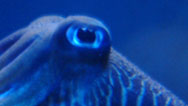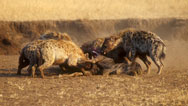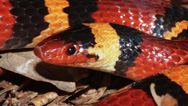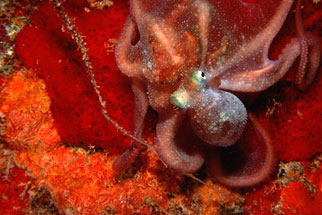Hiding in Plain Sight
- By David Levin
- Posted 09.02.10
- NOVA scienceNOW
Many animals have evolved the ability to camouflage themselves to avoid predators. But few of them do it quite as well as the octopus, which can change its skin color and body shape to blend into almost any background. In this audio story, marine biologist Roger Hanlon describes the octopus's remarkable skill.
Transcript
Hiding in Plain Sight
Posted September 2, 2010
DAVID LEVIN: You're listening to a NOVA podcast. I'm David Levin.
If you've ever seen one of the Harry Potter movies—and I've seen them all—you may have lusted over Harry's fantastic invisibility cloak. Just think what it'd be like to move from place to place, unseen, unnoticed. It'd be a great party trick.
Well, in the real world, staying hidden doesn't take magic. It takes elaborate camouflage. That's something a lot of animals have evolved—but few of them use it quite as well as the octopus.
ROGER HANLON: One of the most interesting and complex behaviors is their ability to camouflage, no matter where they go.
DAVID LEVIN: Roger Hanlon studies octopuses at the Marine Biology Lab in Woods Hole, Massachusetts. He says staying hidden is essential if you're a soft-bodied animal like an octopus.
ROGER HANLON: Because everything in the ocean is trying to eat them! They're a central part of the food chain.
DAVID LEVIN: So to avoid that fate, they've evolved some of the most amazing skin in the animal world.
ROGER HANLON: They go to any background they might encounter in the richest visual environments on earth—that's coral reefs and kelp forests—and they can very swiftly assess the visual background and implement a very elegant pattern that achieves camouflage.
DAVID LEVIN: Thanks to special organs called chromatophores, Hanlon says an octopus can change its skin pigment to match almost any color or pattern in a fraction of a second.
ROGER HANLON: Now, that's a capability that no vertebrate animal has, and even the other invertebrate animals that can do it quite well don't do it this well. So, it fits in with one of their primary needs, and that is to survive and not get eaten while they themselves live and grow and eat and reproduce.
DAVID LEVIN: Hanlon says that an octopus can also change its body shape to match its surroundings. And that can help it move across areas where it's completely exposed.
ROGER HANLON: And we've observed and filmed this behavior where the octopus forms its body like a rock and takes on the coloration and patterning of an adjacent rock or coral. And then with its eight arms, each with 200 suckers, it sort of tippy-toes across the open area. So we call this "the moving rock trick." Now, that really requires a very large brain and coordinated complex behavior with complex body patterning.
DAVID LEVIN: Hanlon says that this ability is helping him rethink what animal "intelligence" really means.
ROGER HANLON: By any measure, this is a cunning, calculating animal doing behaviors that sophisticated. When you see these animals operating under complex environmental conditions, outwitting some of the smartest predators out there—porpoises and diving birds and sea basses and dozens of fishes with keen senses and complex behaviors—you suddenly realize that smart can mean a lot of different things.
Credits
Audio
- Produced by
- David Levin
- Interview by
- Susan K. Lewis
Image
- (octopus)
- © Robert Dalton
Related Links
-

Spineless Smarts
Animal behaviorist Jean Boal ponders what cephalopods might teach us about our own intellect.
-

Your Favorite Smart Animal
Hear experts "pitch" for dogs, cats, honeybees, hyenas, and other smart species, then vote for your favorite.
-

The Perfect Hunter
Could social intelligence be the key to hyenas' deadly hunting skills?
-

Evolution, Mimicry, and Momentum
In North Carolina, a group of snakes survives by impersonating a toxic species that disappeared decades ago.
You need the Flash Player plug-in to view this content.




